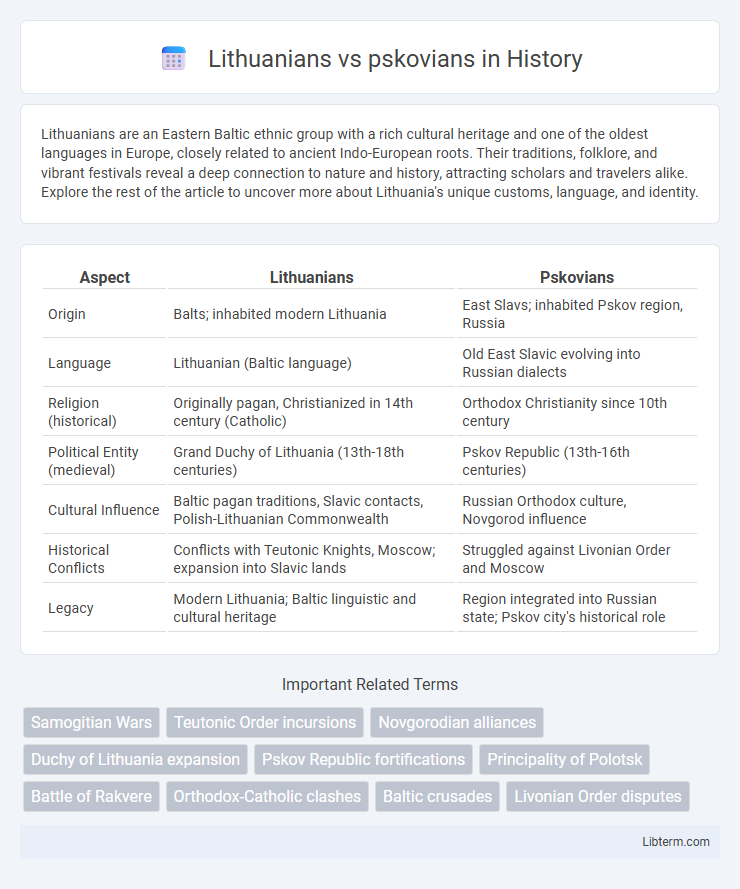Lithuanians are an Eastern Baltic ethnic group with a rich cultural heritage and one of the oldest languages in Europe, closely related to ancient Indo-European roots. Their traditions, folklore, and vibrant festivals reveal a deep connection to nature and history, attracting scholars and travelers alike. Explore the rest of the article to uncover more about Lithuania's unique customs, language, and identity.
Table of Comparison
| Aspect | Lithuanians | Pskovians |
|---|---|---|
| Origin | Balts; inhabited modern Lithuania | East Slavs; inhabited Pskov region, Russia |
| Language | Lithuanian (Baltic language) | Old East Slavic evolving into Russian dialects |
| Religion (historical) | Originally pagan, Christianized in 14th century (Catholic) | Orthodox Christianity since 10th century |
| Political Entity (medieval) | Grand Duchy of Lithuania (13th-18th centuries) | Pskov Republic (13th-16th centuries) |
| Cultural Influence | Baltic pagan traditions, Slavic contacts, Polish-Lithuanian Commonwealth | Russian Orthodox culture, Novgorod influence |
| Historical Conflicts | Conflicts with Teutonic Knights, Moscow; expansion into Slavic lands | Struggled against Livonian Order and Moscow |
| Legacy | Modern Lithuania; Baltic linguistic and cultural heritage | Region integrated into Russian state; Pskov city's historical role |
Historical Background of Lithuanians and Pskovians
Lithuanians, originating from the Baltic tribes, established a powerful Grand Duchy of Lithuania in the 13th century, expanding their influence across Eastern Europe. The Pskovians, inhabitants of the medieval Pskov Republic founded in the 13th century, played a significant role in regional trade and defense against external threats like the Teutonic Order. Both groups engaged in military conflicts and alliances reflecting their strategic positions near the Baltic and Slavic cultural spheres.
Geographic Origins and Territory
Lithuanians originated primarily from the Baltic region, encompassing modern-day Lithuania and parts of Latvia, characterized by dense forests and coastal access to the Baltic Sea. Pskovians inhabited territories around the Pskov region in northwestern Russia, marked by its strategic location near the borders of present-day Estonia and Latvia, with fertile plains and river systems like the Velikaya River. The geographic distinction between Baltic Lithuanian forests and the riverine plains of Pskov shaped their distinct cultural and economic developments throughout medieval history.
Political Structures and Leadership
The Lithuanians developed a centralized political structure under the Grand Duchy of Lithuania, with a strong Grand Duke who wielded considerable authority over a coalition of duchies. In contrast, the Pskovians operated a more decentralized system characterized by the veche, a popular assembly that influenced decision-making alongside the posadnik, an elected official acting as a city governor. This difference underscored the Lithuanian emphasis on dynastic leadership and territorial expansion, while Pskov maintained a form of republican governance with significant local autonomy.
Cultural and Religious Differences
Lithuanians, predominantly Roman Catholic since the late 14th century, developed a distinct cultural identity rooted in Baltic traditions, folklore, and language, preserving pagan elements alongside Christian practices. Pskovians, primarily Eastern Orthodox Christians, maintained strong ties with the Russian Orthodox Church, which deeply influenced their art, architecture, and social customs. These religious affiliations fostered divergent cultural developments, with Lithuanians emphasizing Latin liturgy and Western European connections, while Pskovians aligned with Byzantine rites and Slavic heritage.
Language and Linguistic Heritage
Lithuanians speak Lithuanian, one of the oldest living Baltic languages, preserving many archaic Indo-European features that provide crucial insight into the history of the language family. In contrast, Pskovians traditionally speak a dialect of Russian, part of the East Slavic subgroup, which has evolved with strong influences from Old Church Slavonic and neighboring Finno-Ugric languages. The linguistic heritage of Lithuanians reflects a unique Baltic identity rooted in ancient linguistic structures, whereas Pskovian language traditions illustrate the dynamic blending typical of Russian regional dialects.
Military Conflicts and Alliances
Lithuanians and Pskovians engaged in multiple military conflicts during the 14th and 15th centuries, primarily over territorial control in the Baltic region. The Grand Duchy of Lithuania often clashed with the Pskov Republic, which was allied with the Novgorod Republic and later the Grand Duchy of Moscow, intensifying regional power struggles. Periodic alliances shifted as both parties sought strategic advantages, with Lithuania sometimes collaborating with Livonian Order forces against Pskov to consolidate influence along key trade routes.
Trade and Economic Relations
Lithuanian and Pskovian trade relations thrived during the medieval period, centered around the exchange of grain, timber, and furs vital to Baltic and Russian markets. Pskov, as a prominent trading hub, facilitated economic ties by granting Lithuanian merchants access to its bustling fairs and river routes connecting the Baltic Sea to interior Russia. This trade cooperation bolstered regional economies and fostered mutual dependence despite occasional political conflicts between the Grand Duchy of Lithuania and the Pskov Republic.
Influences from Neighboring Nations
The Lithuanians and Pskovians both experienced significant influences from neighboring nations, shaping their cultural and political landscapes. Lithuanian culture was heavily impacted by Polish and Russian interactions, which introduced Catholicism and Orthodox Christianity, as well as political alliances through the Polish-Lithuanian Commonwealth. Pskovians, situated near Novgorod and later integrated into the Russian state, absorbed Orthodox Christian traditions and Russian governance structures, creating a distinct regional identity influenced by Slavic culture and Eastern Orthodoxy.
Legacy and Historical Impact
The Lithuanians and Pskovians have left distinct legacies shaping Eastern European history through their political and cultural developments. Lithuanian Grand Duchy expansion during the 13th-15th centuries influenced the region's religious landscape and governance structures, while Pskovians, as a medieval republic, preserved unique legal traditions and trade networks along the Baltic coast. Their historical impact continues in modern national identities and regional cooperation within the Baltic and Slavic spheres.
Modern Perceptions and Identities
Modern perceptions of Lithuanians and Pskovians reflect distinct regional identities shaped by historical interactions and cultural heritage. Lithuanians emphasize their Baltic linguistic and cultural roots, highlighting their national resilience and European Union membership as key identity markers. Pskovians, rooted in Russian heritage, often focus on their historical role as a gateway between Russia and Northern Europe, fostering a local identity intertwined with Russian Orthodox traditions and regional autonomy within Russia.
Lithuanians Infographic

 libterm.com
libterm.com